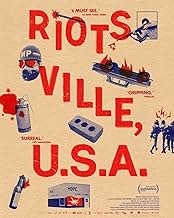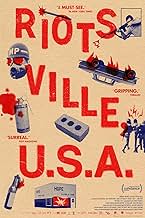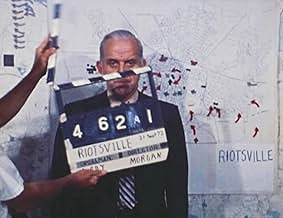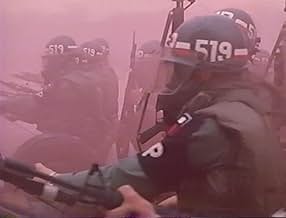अपनी भाषा में प्लॉट जोड़ेंWelcome to Riotsville, a fictional town built by the US military. Using all archival footage, the film explores the militarization of the police and creates a counter-narrative to the nation... सभी पढ़ेंWelcome to Riotsville, a fictional town built by the US military. Using all archival footage, the film explores the militarization of the police and creates a counter-narrative to the nation's reaction to the uprisings of the late '60s.Welcome to Riotsville, a fictional town built by the US military. Using all archival footage, the film explores the militarization of the police and creates a counter-narrative to the nation's reaction to the uprisings of the late '60s.
- पुरस्कार
- 4 जीत और कुल 10 नामांकन
Lyndon B. Johnson
- Self
- (आर्काइव फ़ूटेज)
Otto Kerner
- Self - Chairman
- (आर्काइव फ़ूटेज)
- (as Governor Otto Kerner)
Edward P. Morgan
- Self - PBL Chief Correspondent
- (आर्काइव फ़ूटेज)
Robert Curvin
- Self - Former Chairman, Neward CORE
- (आर्काइव फ़ूटेज)
Leonard Kowalewski
- Self - Newark Police
- (आर्काइव फ़ूटेज)
John Harrington
- Self - Fraternal Order of Police
- (आर्काइव फ़ूटेज)
- (as Sgt. John Harrington)
Albert Cleage
- Self
- (आर्काइव फ़ूटेज)
- (as The Rev. Albert Cleage)
Alvin F. Poussaint
- Self - Tufts University
- (आर्काइव फ़ूटेज)
- (as Dr. Albert Poussaint)
Fred Harris
- Self - Commission Member
- (आर्काइव फ़ूटेज)
- (as Sen. Fred R Harris)
Dick Gregory
- Self
- (आर्काइव फ़ूटेज)
Roger Mudd
- Self
- (आर्काइव फ़ूटेज)
Robert Byrd
- Self
- (आर्काइव ध्वनि)
- (as Senator Robert Byrd)
Jimmy Collier
- Self
- (आर्काइव फ़ूटेज)
Frederick Douglass Kirkpatrick
- Self
- (आर्काइव फ़ूटेज)
- (as Rev. Frederick Douglass Kirkpatrick)
Ronald Reagan
- Self
- (आर्काइव फ़ूटेज)
Spiro Agnew
- Self
- (आर्काइव फ़ूटेज)
- (as Gov. Spiro Agnew)
Strom Thurmond
- Self
- (आर्काइव फ़ूटेज)
- (as Sen. Strom Thurmond)
फ़ीचर्ड समीक्षाएं
The trailer for this movie focused on the fake towns - they look like movie sets - that were built in the 1960s so that the Army could practice dealing with "race riots."
As it turns out in the movie, there were only two such Riotsvilles, and they play only a very small roll in this movie. That's very unfortunate, imo. I would have liked to know how they were financed - did Congress know about them? - how the soldiers were chosen to stage crowd control in them, etc. In other words, I would have appreciated it if the movie had concentrated on the riotsvilles.
Instead, most of the movie deals with the Civil Rights Movement and white reaction to it in the 1960s. That's interesting, of course, but nothing new. Sometimes it really seemed like filler for a movie that should have been a short rather than a feature-length film.
The narration got a little shrill at times for my tastes. The images and newsreel footage that are the basis of this movie are already powerful, and speak for themselves Since no one opposed to the Civil Rights Movement is going to watch this movie, there's no point in preaching to the already converted.
An ok movie, in short, but not enough new material to warrant its 91 minute run time.
As it turns out in the movie, there were only two such Riotsvilles, and they play only a very small roll in this movie. That's very unfortunate, imo. I would have liked to know how they were financed - did Congress know about them? - how the soldiers were chosen to stage crowd control in them, etc. In other words, I would have appreciated it if the movie had concentrated on the riotsvilles.
Instead, most of the movie deals with the Civil Rights Movement and white reaction to it in the 1960s. That's interesting, of course, but nothing new. Sometimes it really seemed like filler for a movie that should have been a short rather than a feature-length film.
The narration got a little shrill at times for my tastes. The images and newsreel footage that are the basis of this movie are already powerful, and speak for themselves Since no one opposed to the Civil Rights Movement is going to watch this movie, there's no point in preaching to the already converted.
An ok movie, in short, but not enough new material to warrant its 91 minute run time.
Originally premiered at the 2022 Sundance Film Festival in the NEXT selection.
Director Sierra Pettengill makes a documentary about a fictional town named Riotsville which was built by the US military and explores the militarization of the police and creates a counter-narrative to the nation's reaction to the uprisings of the late '60s. The issues of police and riots are still a very common theme in the modern days. This documentary may be considered relevant in todays time because of all the political things happening at this very moment.
The music choice to create an uneven tension really helps to make you feel uneasy of what you are learning, the narration from Charlene Modeste does really help to add an feeling of uneasiness while you are witnessing archival footage of riots and insane things happening. There are some really good conversations from political members, citizens, news people, and others that are presented in this documentary to capture a realistic point of view.
However, the editing becomes really sloppy and some of the technical moments are noticeably bad. As if there are some errors during post-production when making this movie. Overall, a good documentary.
Rating: B.
Director Sierra Pettengill makes a documentary about a fictional town named Riotsville which was built by the US military and explores the militarization of the police and creates a counter-narrative to the nation's reaction to the uprisings of the late '60s. The issues of police and riots are still a very common theme in the modern days. This documentary may be considered relevant in todays time because of all the political things happening at this very moment.
The music choice to create an uneven tension really helps to make you feel uneasy of what you are learning, the narration from Charlene Modeste does really help to add an feeling of uneasiness while you are witnessing archival footage of riots and insane things happening. There are some really good conversations from political members, citizens, news people, and others that are presented in this documentary to capture a realistic point of view.
However, the editing becomes really sloppy and some of the technical moments are noticeably bad. As if there are some errors during post-production when making this movie. Overall, a good documentary.
Rating: B.
This film struggles with some fascinating archival footage and trying to stretch both the length and message of the film too broadly around that.
This country struggles with civil rights sadly over and over again, now to the point where the one thing uniting far too many citizens is an unwavering distrust of the government. Documenting protests is important in understanding both the strength and vulnerability of the not-always-so-United States. That said I feel like any assembly of mobs...protesters (also I guess anti-protesters generally few but vociferous) and then the police force can bring out the mob mentality on both sides.
In general color me wary of both, but especially the ones where everyone in the mob has a gun.
Anyways this film might best be served by watching the trailer or a sped-up or excerpted version of it. I assume the abridged version won't have the slow zoom and defocus on pixelated faces. Although that would do a disservice to DJ Rupture's excellent soundtrack work.
Looking forward... 1) Well I do think for all of the struggles, the arc or the USA does bend towards a better country...often painfully and painfully slowly.
2) The notion of test cities for police exercises is still going on afaik, didn't the former Blackwater corporation utilize them recently before they re-branded or whatever?
3) Sierra Pettengill might be an excellent resource for gathering archival footage for other directors' projects. I see she was part of the team for the Jarmusch documentary on the The Stooges (with Iggy that is, not Curly).
I struggle to recommend this, but with expectations lowered for less of an expose and more of an art collage meditation with occasional Gulf advertisements - it might be worth an hour of your time, although the running time is 1.5 hours.
This country struggles with civil rights sadly over and over again, now to the point where the one thing uniting far too many citizens is an unwavering distrust of the government. Documenting protests is important in understanding both the strength and vulnerability of the not-always-so-United States. That said I feel like any assembly of mobs...protesters (also I guess anti-protesters generally few but vociferous) and then the police force can bring out the mob mentality on both sides.
In general color me wary of both, but especially the ones where everyone in the mob has a gun.
Anyways this film might best be served by watching the trailer or a sped-up or excerpted version of it. I assume the abridged version won't have the slow zoom and defocus on pixelated faces. Although that would do a disservice to DJ Rupture's excellent soundtrack work.
Looking forward... 1) Well I do think for all of the struggles, the arc or the USA does bend towards a better country...often painfully and painfully slowly.
2) The notion of test cities for police exercises is still going on afaik, didn't the former Blackwater corporation utilize them recently before they re-branded or whatever?
3) Sierra Pettengill might be an excellent resource for gathering archival footage for other directors' projects. I see she was part of the team for the Jarmusch documentary on the The Stooges (with Iggy that is, not Curly).
I struggle to recommend this, but with expectations lowered for less of an expose and more of an art collage meditation with occasional Gulf advertisements - it might be worth an hour of your time, although the running time is 1.5 hours.
But this was far below what i expected from a historical perspective. Its the black and white stigmata over and over again, and what really should be delved with, namely how antiriot enforcement where thought to be and how it came to be in the name of riotsville usa drowns in a claustrophobic, cataclysmic psychedelic epileptic triggering lightshows and overfocused still, and a neoneoneoultra composed musical scored( like norwegian composer arne nordheim) makes this a complete rotten mess historywise. Its narrative voice never tells how much was spended or how large this antiriotforce buildup was, and the real riots that couldve made this documentary a real document of history lacks completely.
So if this is how riots have been handled over the years then its time to look somewhere else. As a filmproduct it lacks quality on most bases, and the amount of positive criticism over a ribbed and untelling way to tell a story that has been told here really feels fictitious. The grumpy old man doesnt recommend this one, and will cry out a call to the big documentarymakers to make a series about the real rioting 60's and the real face of the crammed crow.
So if this is how riots have been handled over the years then its time to look somewhere else. As a filmproduct it lacks quality on most bases, and the amount of positive criticism over a ribbed and untelling way to tell a story that has been told here really feels fictitious. The grumpy old man doesnt recommend this one, and will cry out a call to the big documentarymakers to make a series about the real rioting 60's and the real face of the crammed crow.
It's unfortunate when a film has an important message to convey but does a poor job of saying what it has to say. That's the problem with this documentary about the policies and practices underlying government efforts to control violent civil disobedience in major US cities during the mid to late 1960s. It focuses on the training programs employed at US Army bases where model cities (called "Riotsville") were built to stage simulated disturbances used for instructing military and police forces on how to quell such outbreaks in line with official government policies. But the film goes beyond that, trying to explain why these incidents were occurring with increasing frequency at the time and why such extensive training measures had become necessary. In doing so, the picture examines the frustrations associated with, and subsequent reactions to, the issues of poverty, racism, police brutality, inequality and the impact of the Vietnam War, among others, principally in minority inner city communities. It tells this story using only archive footage from the time, drawn from television broadcasts and official US military training films. However, given the broad scope of this story, director Sierra Pettengill's third feature outing doesn't delve nearly deep enough into these issues, somewhat surprising given the wealth of material at the filmmaker's disposal. Nor does it tie the Riotsville project to these larger questions as well as it could, relying more on implication than connection. Moreover, this shallow, underdeveloped approach is further undercut by a number of poorly chosen video segments and others in desperate need of editing out extraneous content. Add to that far too many explanatory subtitles and a number of dull, overwritten voiceovers seeking to philosophically elaborate on its conclusions, and you've got a watered down presentation of material deserving to be delivered with a greater sense of hard-hitting urgency. This is the sort of film that should make audiences angry, not put them to sleep, but this offering does more to promote the latter than the former. This is a story that would have been better told through more skillful directorial hands for it to have the impact it requires. Unfortunately, that's not the case here.
टॉप पसंद
रेटिंग देने के लिए साइन-इन करें और वैयक्तिकृत सुझावों के लिए वॉचलिस्ट करें
- How long is Riotsville, U.S.A.?Alexa द्वारा संचालित
विवरण
बॉक्स ऑफ़िस
- US और कनाडा में सकल
- $40,960
- US और कनाडा में पहले सप्ताह में कुल कमाई
- $5,597
- 18 सित॰ 2022
- दुनिया भर में सकल
- $44,392
- चलने की अवधि
- 1 घं 31 मि(91 min)
- रंग
इस पेज में योगदान दें
किसी बदलाव का सुझाव दें या अनुपलब्ध कॉन्टेंट जोड़ें

























